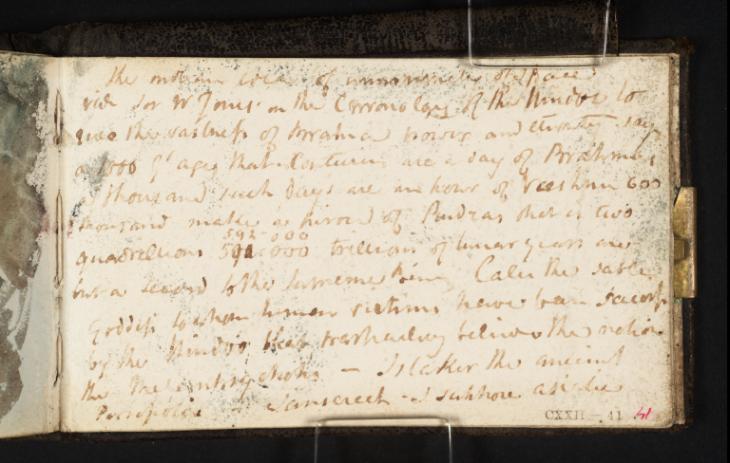Joseph Mallord William Turner Inscription by Turner: Notes from Sir William Jones's 'On the Chronology of the Hindus' and 'On the Gods of Greece, Italy and India' c.1807-14
Joseph Mallord William Turner,
Inscription by Turner: Notes from Sir William Jones's 'On the Chronology of the Hindus' and 'On the Gods of Greece, Italy and India'
c.1807-14
Joseph Mallord William Turner 1775–1851
Folio 41 Recto:
Inscription by Turner: Notes from Sir William Jones’s ‘On the Chronology of the Hindus’ and ‘On the Gods of Greece, Italy and India’ c.1807–14
D08348
Turner Bequest CXXII 41
Turner Bequest CXXII 41
Pen and ink on white wove paper, 69 x 112 mm
Inscribed by John Ruskin in red ink ‘41’ bottom right
Stamped in black ‘CXXII – 41’ bottom right
Inscribed by John Ruskin in red ink ‘41’ bottom right
Stamped in black ‘CXXII – 41’ bottom right
Accepted by the nation as part of the Turner Bequest 1856
References
1909
A.J. Finberg, A Complete Inventory of the Drawings of the Turner Bequest, London 1909, vol.I, p.341, CXXII 41, as ‘Notes on Brahma continued’.
1974
Gerald Wilkinson, The Sketches of Turner, R.A. 1802–20: Genius of the Romantic, London 1974, reproduced p.124 (colour).
1977
Gerald Wilkinson, Turner Sketches 1789–1820, London 1977, reproduced p.126 (colour).
1981
Evelyn Joll, ‘Yorkshire Symposium’, Turner Studies, vol.1, no.1, Summer 1981, p. 42.
1981
William Chubb, ‘Minerva Medica and The Tall Tree’, Turner Studies, vol.1, No.2, Winter 1981, pp.28, 34–5.
1990
Kathleen Nicholson, Turner’s Classical Landscapes: Myth and Meaning, Princeton 1990, pp.152, 213 note 16.
1997
Anthony Bailey, Standing in the Sun: A Life of J.M.W. Turner, London 1997, pp.161–2.
The whole page is taken up with the following notes in ink:
the [...] idea of immensity of space. | vide for W Jones on the Chronology of the Hindoo to | [?give] the vastness of Brahmas power and eternity says | a 1000 of ages that continue are a day of Brahme, | a thousand such days are an hour of Vishnu 600 | thousand make a period of Rudras that is two | quadrillions 590–000 [‘592–000’ inserted above] trillions of lunar years are | but a second to the Supreme Being Calii the sable | Goddess to whom human victims have been sacrif | by the Hindoo that [?particularly] believe the notion | the [...] – [...] the ancient | [?Proserpina] – Sanscreet – I suppose Asiatic1
William Chubb has identified Turner’s text as taken from ‘On the Chronology of the Hindus’ and ‘On the Gods of Greece, Italy and India’ by the Orientalist Sir William Jones (1746–1794).2 He transcribes Jones’s texts as follows; firstly from the ‘Chronology’, published in volume I of Asiatick Researches (1789) and again in volume I of Jones’s Works (1799):
In the preface to a Varanes Almanack I find the following wild stanza: ‘A thousand Great Ages are a day of Brahma; a thousand such days are an Indian hour of Vishnu; six hundred thousand such hours make a period of Rudra; and a million of Rudras (or two quadrillions five hundred and ninety-two thousand trillions of lunar years), are but a second to the Supreme Being.3
The relevant passage of ‘On the Gods’, published in volume II of Asiatick Researches (1790) and again in Jones’s Works immediately following the ‘Chronology’ quoted above, reads:
The last of the Greek or Italian divinities, for whom we find a parallel in the Pantheon of India, is the Stygian or Taurick Diana, otherwise named Hecate, and often confounded with Proserpine; and there can be no doubt of her identity with Cali, or the wife of Siva in his character of the Stygian Jove. To this black goddess with a collar of golden skulls, as we see her exhibited in all her principle [sic] temples, human sacrifices were anciently offered, as the Vedas enjoined; ...4
There are other passages concerning non-Christian religions on folios 40 recto and 42 recto (D08346, D08350). Chubb has suggested that Turner might have had access to at least one of the texts through patrons with antiquarian interests such as Sir Richard Colt Hoare or Richard Payne Knight;5 he has related those here and on D08348 to Turner’s interest in India, and in particular his introduction of apparently Hindu Indian figures in the otherwise classical European landscapes of two subjects in the Liber Studiorum series of landscape engravings.6
See the present author’s entries for the watercolour studies relating to the Liber subjects elsewhere in this catalogue: The Temple of Minerva Medica (‘Hindoo Devotions’ or ‘The Hindoo Worshipper’) of about 1808 (Tate D08128; Turner Bequest CXVII A), published in 1811 (Tate impressions: A00956, A00957); and Scene in the Campagna (‘Woman at a Tank’ or ‘Hindoo Ablutions’), sometimes also called ‘The Tall Tree’, also of about 1808 (Tate D08141; Turner Bequest CXVII N), published in 1812 (Tate impressions: A00986, A00987). Chubb notes the presence of drawings in this sketchbook which may be from 1807 or earlier (see under folio 9 recto; D08297), implying that the notes here could have preceded and informed the two Liber designs.7
John Gage has discussed Turner’s wider interests in comparative religion,8 and Kathleen Nicholson has also acknowledged Chubb’s interpretation of the artist’s notes.9 Wilkinson reproduces this page only by association with the watercolour on folio 40 verso opposite (D08347), without further comment.10
Ibid., p.35; transcribed in turn from the reprinted text in P.J. Marshall, The British Discovery of Hinduism in the Eighteenth Century, Cambridge 1970, p.265.
Technical notes:
There is a little watercolour offsetting from folio 40 verso opposite (D08347).
Matthew Imms
September 2013
How to cite
Matthew Imms, ‘Inscription by Turner: Notes from Sir William Jones’s ‘On the Chronology of the Hindus’ and ‘On the Gods of Greece, Italy and India’ c.1807–14 by Joseph Mallord William Turner’, catalogue entry, September 2013, in David Blayney Brown (ed.), J.M.W. Turner: Sketchbooks, Drawings and Watercolours, Tate Research Publication, September 2014, https://www

